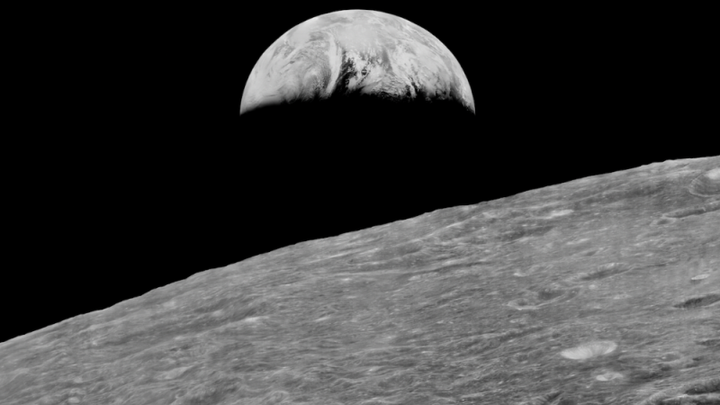
Moon 1966-67: Lunar Photographs
In 1966 and 1967 NASA, to prepare for the Apollo moon landings, launched five spacecraft designed to take detailed images and map the surface of the Moon, our nearest celestial neighbor. From the first view of the Earth from the Moon, to what Life magazine pronounced as the image of the century – a bird’s eye view of the majestic crater Copernicus – the images transmitted back to Earth wowed us. The satellites, with their state of the art dual-lens Kodak cameras, film processing units, readout scanners, and film handling apparatus successfully mapped 98% of The Moon’s surface and provided us with over 1700 incredible narrow angle high resolution and wide angle medium resolution images. Featured here below is the world famous first "Earthrise" from the Moon, the first ever image of the Earth from the Moon.
With the demise of the Apollo program use and interest these images faded from the public view. In 2007, with NASA again considering a return to the moon, became interested in these historic photographs. The Lunar Orbiter Image Recovery Project, or LOIRP was founded in 2007 to resurrect the original high quality photographs by going back to 1960’s magnetic tapes to reprocess them using modern techniques. The team, working out of an abandoned McDonalds restaurant (the project was nicknamed McMoons) at NASA Ames overcame numerous obstacles spent many long hours researching these past engineering efforts, and even coined a new word for their process- “Technoarchaeology” - the study of old technology, how it works, and how to obtain the data that would otherwise be lost.
Here is a video about our project that was done by the Carnegie Musem of Art.
Here is a picture of McMoons that was taken before the removal of the cladding on the famous hanger one at Moffett Field. McMoon's with its Pirate Flag in the Window
McMoon's with its Pirate Flag in the Window
The first image LOIRP recovered was “Earthrise,” reconstructed in 2008 and was shown on the front pages of the Los Angeles Times, and written about on The New York Times Op Ed page. Since 2008 LOIRP has been able to not only recover almost 98% of the original photographs, but reproduce them in much higher resolution and with enhanced details. We are ready to share them with the world.
Our art team has developed a beautiful book featuring the most striking of these magisterial lunar photographs, along with essays on the history of Lunar Orbiter Missions, the efforts of the LOIRP team, and technical information about the image capture processes.
This is what the Dust Jacket of the Book Will Look LIke Dust Jacket and Inside Cover of the Book
Dust Jacket and Inside Cover of the Book
The Book Size, a fine art book at 24" wide.
The book Half Height is 14" making for 28" Tall!
The story of Lunar Orbiter, the LOIRP Project, and the finest film cameras ever made, from the Lunar Orbiters will be described. 
A total of 40 pages of text and lunar images will be yours to enjoy as a collectable of lunar images and history! Above are mock up pages for an explanatory of the famous "Earthrise" Image.
We are seeking funding to complete the book, and to produce fine art prints of these beautiful images to share with the public. Our project has won many accolades across the world. We have been nominated this year for the Ordway Prize, which is a prize given for outstanding work in the preservation of space history. You can follow a few links here to see some of the articles on our project. It is our plan to also continue our lunar development work, as Skycorp CEO Dennis Wingo is a leading proponent of this effort.
Our Wikipedia Page
Carnegie Museum of Art Short
The MIT Technology Review
We are also providing, to donors, certificates of recogntion and large posters of our beautifully restored images.
Here are some more of the type of images that will be in the book!
Second Earthrise, less well known, but taken just a couple of orbits after the first earthrise. This Image of Copernicus Crater was called the "Image of the Century" in 1966
This Image of Copernicus Crater was called the "Image of the Century" in 1966
This Image, from Lunar Orbiter IV, was colorized by world famous space artist, Don Davis...
The landing site of Apollo 15, at Hadley Rille.
An Image that no human eye ever beheld before 1967, This is Mare Orientale, one of the largest impact features on the Moon.
Here are three images of the Earth, from different days, taken from lunar orbiter. 
The Earth, as Seen from Lunar Orbit 1966, 67
Looking down from the North Pole of the Moon
Lunar Orbiter IV Image of the Dark and Light Side of the Moon.